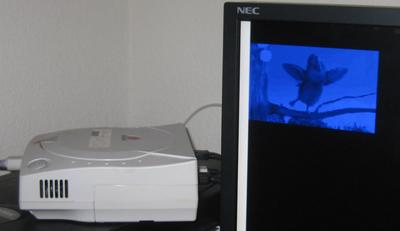I wanted to write down some notes about compiling Linux on Dreamcast (which I have yet to follow through to success). But before I do, allow me to follow up on my last post where I got Google’s libvpx library decoding VP8 video on the DC. Remember when I said the graphics hardware could only process variations of RGB color formats? I was mistaken. Reading over some old documentation, I noticed that the DC’s PowerVR hardware can also handle packed YUV textures (UYVY, specifically):

The video looks pretty sharp in the small photo. Up close, less so, due to the low resolution and high quantization of the test vector combined with the naive chroma upscaling. For the curious, the grey box surrounding the image highlights the 256-square texture that the video frame gets plotted on. Texture dimensions have to be powers of 2.
Notes on Linux for Dreamcast
I’ve occasionally dabbled with Linux on my Dreamcast. There’s an ancient (circa 2001) distro based around a build of kernel 2.4.5 out there. But I wanted to try to get something more current compiled. Thus far, I have figured out how to cross compile kernels pretty handily but have been unsuccessful in making them run.
Here are notes are the compilation portion:
Continue reading




